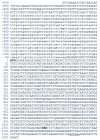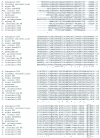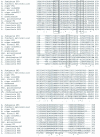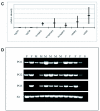Molecular cloning and expression of three polygalacturonase cDNAs from the tarnished plant bug, Lygus lineolaris
- PMID: 20233096
- PMCID: PMC3061599
- DOI: 10.1673/031.008.2701
Molecular cloning and expression of three polygalacturonase cDNAs from the tarnished plant bug, Lygus lineolaris
Abstract
Three unique cDNAs encoding putative polygalacturonase enzymes were isolated from the tarnished plant bug, Lygus lineolaris (Palisot de Beauvois) (Hemiptera: Miridae). The three nucleotide sequences were dissimilar to one another, but the deduced amino acid sequences were similar to each other and to other polygalacturonases from insects, fungi, plants, and bacteria. Four conserved segments characteristic of polygalacturonases were present, but with some notable semiconservative substitutions. Two of four expected disulfide bridge-forming cysteine pairs were present. All three inferred protein translations included predicted signal sequences of 17 to 20 amino acids. Amplification of genomic DNA identified an intron in one of the genes, Llpg1, in the 5' untranslated region. Semiquantitative RT-PCR revealed expression in all stages of the insect except the eggs. Expression in adults, male and female, was highly variable, indicating a family of highly inducible and diverse enzymes adapted to the generalist polyphagous nature of this important pest.
Figures







Similar articles
-
Expression and RNA interference of salivary polygalacturonase genes in the tarnished plant bug, Lygus lineolaris.J Insect Sci. 2010;10:173. doi: 10.1673/031.010.14133. J Insect Sci. 2010. PMID: 21062205 Free PMC article.
-
Biology, Ecology, and Pest Management of the Tarnished Plant Bug, Lygus lineolaris (Palisot de Beauvois) in Southern Row Crops.Insects. 2021 Sep 9;12(9):807. doi: 10.3390/insects12090807. Insects. 2021. PMID: 34564247 Free PMC article. Review.
-
Identification of Genes Potentially Responsible for extra-Oral Digestion and Overcoming Plant Defense from Salivary Glands of the Tarnished Plant Bug (Hemiptera: Miridae) Using cDNA Sequencing.J Insect Sci. 2016 Jun 20;16(1):60. doi: 10.1093/jisesa/iew041. Print 2016. J Insect Sci. 2016. PMID: 27324587 Free PMC article.
-
Cytochrome P450 CYP6X1 cDNAs and mRNA expression levels in three strains of the tarnished plant bug Lygus lineolaris (Heteroptera: Miridae) having different susceptibilities to pyrethroid insecticide.Insect Mol Biol. 2003 Feb;12(1):39-49. doi: 10.1046/j.1365-2583.2003.00385.x. Insect Mol Biol. 2003. PMID: 12542634
-
Establishing an IPM System for Tarnished Plant Bug (Hemiptera: Miridae) in North Carolina.Insects. 2025 Feb 5;16(2):164. doi: 10.3390/insects16020164. Insects. 2025. PMID: 40003795 Free PMC article. Review.
Cited by
-
Duplication and expression of horizontally transferred polygalacturonase genes is associated with host range expansion of mirid bugs.BMC Evol Biol. 2019 Jan 9;19(1):12. doi: 10.1186/s12862-019-1351-1. BMC Evol Biol. 2019. PMID: 30626314 Free PMC article.
-
Expression and RNA interference of salivary polygalacturonase genes in the tarnished plant bug, Lygus lineolaris.J Insect Sci. 2010;10:173. doi: 10.1673/031.010.14133. J Insect Sci. 2010. PMID: 21062205 Free PMC article.
-
Biology, Ecology, and Pest Management of the Tarnished Plant Bug, Lygus lineolaris (Palisot de Beauvois) in Southern Row Crops.Insects. 2021 Sep 9;12(9):807. doi: 10.3390/insects12090807. Insects. 2021. PMID: 34564247 Free PMC article. Review.
-
Functional Classification and Characterization of the Fungal Glycoside Hydrolase 28 Protein Family.J Fungi (Basel). 2022 Feb 22;8(3):217. doi: 10.3390/jof8030217. J Fungi (Basel). 2022. PMID: 35330219 Free PMC article.
-
Insight into the Salivary Gland Transcriptome of Lygus lineolaris (Palisot de Beauvois).PLoS One. 2016 Jan 20;11(1):e0147197. doi: 10.1371/journal.pone.0147197. eCollection 2016. PLoS One. 2016. PMID: 26789269 Free PMC article.
References
-
- Agblor A, Henderson HM, Madrid FJ. Characterization of alpha-amylase and polygalacturonase from Lygus spp. (Heteroptera: Miridae). Food Research International. 1994;27:321–326.
-
- Agusti N, Cohen A. Lygus hesperus and L. lineolaris (Hemiptera: Miridae): the salivary and midgut enzymes. Journal of Entomological Science. 2000;35:175–182.
-
- Allen ML. Expressed sequenced tags from Lygus lineolaris (Hemiptera: Miridae), the tarnished plant bug. Genetics and Molecular Research. 2007;6:206–213. - PubMed
-
- Armand S, Wagemaker MJ, Sanchez-Torres P, Kester HC, van Santen Y, Dijkstra BW, Visser J, Benen JA. The active site topology of Aspergillus niger endopolygalacturonase II as studied by site-directed mutagenesis. Journal of Biological Chemistry. 2000;275:691–696. - PubMed
MeSH terms
Substances
Associated data
- Actions
- Actions
- Actions
LinkOut - more resources
Full Text Sources
Other Literature Sources

